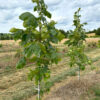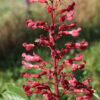This month we turn to the most wide-ranging native tree in eastern North America, the red maple, Acer rubrum, also known as swamp, water, or soft maple. Red maple inhabits a broad variety of habitats across virtually the entire continent east of the 95th parallel and south of the -40 °C winter isotherm (roughly 47° to 50° north latitude) with the exceptions of the Louisiana and Texas Gulf Coasts, the Everglades, and the ‘Prairie Peninsula’ of Iowa and Illinois. It is a primary colonizer of open meadows and timbered forests, while relatively rare in old-growth and other mature woods, due to its relatively short life (typically 100-125 years) and intolerance of shade after 5-8 years of growth. In southern areas of its range, it is primarily confined to swamps and stream valleys, but is more common on drier upland sites further north, primarily at elevations below 900 m (3,000 ft). Red maple’s tolerance of soil types and moisture situations can be primarily attributed to its adaptive root structure (deep taproots and short laterals on dry sites, short taproots and wide-ranging laterals in wet soils) and its odd ability to halt growth completely for up to two weeks in drought. On the other hand, Acer rubrum can tolerate completely saturated soils for up to two months. It frequently hybridizes with its fellow native silver maple (Acer saccharinum); the hybrid is known as Freeman’s maple (Acer ×freemanii).
[Article continues below photos.]
In the wild, Acer rubrum is a fast-growing tree, growing up to 60 cm (2 ft) per year in youth under good conditions and maturing at a height of 25-35 m (85-115 ft). In open situations, it forms a rounded, upright crown. The bark is a smooth silver-grey when young, with darker grey plates on older trees. Dark red leaf buds emerge early, opening to bright-green 4” leaves with 3 to 5 shallow lobes. The species is especially valued for brilliant autumn color, ranging from scarlet to orange to clear yellow. Interestingly, male trees are more likely to turn red, while female trees tend to orange. Small red flowers emerge a few weeks before leaf break; the female flowers rapidly produce abundant seeds which usually disperse before the leaves are fully mature. Like most maples, the fruit is a two-seeded winged samara or ‘helicopter’; 10-inch diameter trees have been documented to produce nearly a million seeds in a season. The seeds can germinate almost immediately and require no dormancy. The seed is unusually viable, even for Acer species; an experiment on a clear-cut field in the Midwest found 900 red maple seedings per acre after six years, making the species a strong colonizer of disturbed areas as noted above.
Young saplings are an important and nutritional wildlife forage crop, especially in winter for white-tailed deer (Odocoileus virginianus) and the snowshoe hare (Lepus americanus). Indigenous Americans used tea made from the outer bark as an eye wash and tea from the inner bark for coughs and stomach ailments. Early settlers made brown and black dyes from the bark extract. The foliage is also host to several species of moths and butterflies. Wilted or dried foliage is, however, extremely toxic to horses and other equines. The wood of red maple is pale and softer than many maples, but also contains a greater density of ‘curly’ or ‘flame’ patterns, valued as veneer and in the construction of musical instruments and customized furniture.
Acer rubrum has been used as an ornamental for centuries and was introduced to Europe as early as 1656. Its rapid growth, early red flowers, moderate shade, and brilliant fall color continue to make it a popular choice. It can thrive in many different situations but grows best in full sun where it can attain its typical landscape height of 15-25 m (50-85 ft). Red maple should be sited away from sidewalks and foundations due to its relatively shallow lateral roots. It tolerates pruning well and is not particularly susceptible pests, but young trees should be mulched to guard the thin bark from damage from string trimmers and other equipment.
White House Natives grows Acer rubrum in a range of sizes from 1¾ to 3”caliper. And in purchasing from WHN, you know you will have stock adapted to Virginia’s variable climate.







